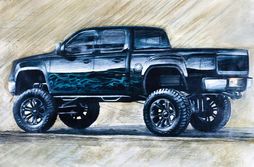 ~by Amanda Smith On our way to school one morning, my son noticed the particularly enormous, jacked up Ford F150 in front of us. Honestly, one couldn’t miss it. The sun danced on its shimmering black body, with shiny silver decals, and its upgraded suspension revealed a dazzling chrome plated differential. “Why do people do that?” my sensible son asked. “Why do you think people do that?” I stalled while reaching for my sunglasses. “Maybe to go off road?” Mr. Practical said. “Because it looks cool,” the young idealist in the back seat chimed in. In silence we considered the brilliant black beast. As it veered to our right we pondered the larger-than-life wheels, their chrome rims happily casting sun stars in our eyes. “Well,” said Mr. Practical, “it certainly adds interest.” And with that he got me thinking. A pick-up truck is the ultimate utility vehicle. America’s workhorse. Full-on functionality. The contractors’ reliable staple. Like plot. Plot is the writer’s Ford F150. It steadily carries all our tools, our characters, our story, and our devices. But just like pick-up trucks, plots can do with a little bling. So how can we add a lift-kit, decals, or some chrome plating to our writing?
0 Comments
Leave a Reply. |
Peruse blogs for advice and tips from KidLit creatives.
Categories
All
Archives
April 2024
Click to set custom HTML
Click on the RSS Feed button above to receive notifications of new posts on this blog.
|

 RSS Feed
RSS Feed